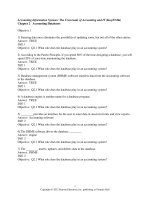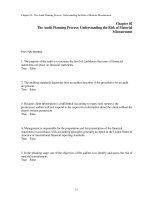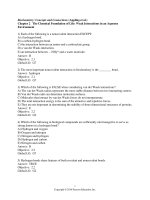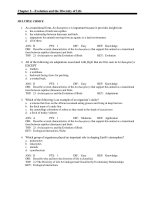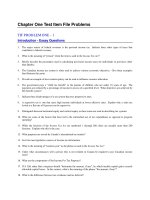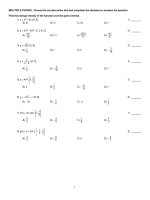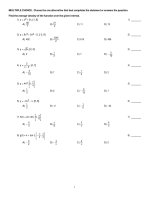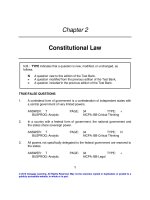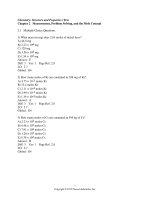Hands on ethical hacking and network defense 1st edition simpson test bank
Bạn đang xem bản rút gọn của tài liệu. Xem và tải ngay bản đầy đủ của tài liệu tại đây (146.78 KB, 8 trang )
ch02
True/False
Indicate whether the statement is true or false.
____
1. No matter what medium connects computers on a network—copper wires, fiber-optic cables, or a wireless
setup—the same protocol must be running on all computers if communication is going to function correctly.
____
2. In the TCP/IP stack, the transport layer includes network services and client software.
____
3. To retrieve e-mail from a mail server, you most likely access port 119.
____
4. An octal digit can be represented with only three bits because the largest digit in octal is 7.
____
5. A hex number is written with two characters, each representing a byte.
Multiple Choice
Identify the choice that best completes the statement or answers the question.
____
____
____
____
____
____
____
____
____
____
6. The most widely used is protocol is ____.
a. IPX/SPX
c. TCP/IP
b. ATM
d. NetBIOS
7. TCP stands for ____.
a. Transfer Control Protocol
c. Transfer Congestion Protocol
b. Transmission Control Protocol
d. THE Control Protocol
8. In the TCP/IP stack, the ____ layer is concerned with physically moving electrons across a media or wire.
a. Internet
c. transport
b. network
d. application
9. In the TCP/IP stack, the ____ layer is concerned with controlling the flow of data, sequencing packets for
reassembly, and encapsulating the segment with a TCP or UDP header.
a. Internet
c. transport
b. network
d. application
10. In the TCP/IP stack, the ____ layer is where applications and protocols, such as HTTP and Telnet, operate.
a. Internet
c. transport
b. network
d. application
11. In the TCP/IP stack, the ____ layer uses IP addresses to route packets to their appropriate destination
network.
a. Internet
c. transport
b. network
d. application
12. The ____ layer protocols are the front ends to the lower-layer protocols in the TCP/IP stack.
a. Internet
c. transport
b. network
d. application
13. UDP stands for ____.
a. User Datagram Protocol
c. User Data Packet
b. Universal Datagram Protocol
d. Universal Data Packet
14. ____ is an attack that relies on guessing the ISNs of TCP packets.
a. ARP spoofing
c. DoS
b. Session hijacking
d. Man-in-the-middle
15. A(n) ____ is the logical, not physical, component of a TCP connection.
____ 16.
____ 17.
____ 18.
____ 19.
____ 20.
____ 21.
____ 22.
____ 23.
____ 24.
____ 25.
____ 26.
____ 27.
____ 28.
____ 29.
____ 30.
a. ISN
c. port
b. socket
d. SYN
The HTTP service uses port ____.
a. 25
c. 69
b. 53
d. 80
The SMTP service uses port ____.
a. 25
c. 69
b. 53
d. 80
The TFTP service uses port ____.
a. 25
c. 69
b. 53
d. 80
The DNS service uses port ____.
a. 25
c. 69
b. 53
d. 80
____ was the de facto standard for moving or copying large files and is still used today, although to a lesser
extent because of the popularity of HTTP.
a. FTP
c. SNMP
b. TFTP
d. SMTP
The POP3 service uses port ____.
a. 110
c. 135
b. 119
d. 139
The Microsoft RPC service uses port ____.
a. 110
c. 135
b. 119
d. 139
The NetBIOS service uses port ____.
a. 110
c. 135
b. 119
d. 139
The Network News Transport Protocol service uses port ____.
a. 110
c. 135
b. 119
d. 139
____ is a fast but unreliable delivery protocol that operates on the transport layer.
a. IP
c. TFTP
b. TCP
d. UDP
____ is a connectionless protocol
a. TCP
c. FTP
b. UDP
d. POP3
Based on the starting decimal number of the ____ byte, you can classify IP addresses as Class A, Class B, or
Class C.
a. first
c. third
b. second
d. fourth
What type of class has the IP address 193.1.2.3?
a. Class A
c. Class C
b. Class B
d. Class D
Each Class C IP address supports up to ____ host computers.
a. 254
c. 65,000
b. 512
d. 16 million
The binary number 11000001 converted to decimal is ____.
a. 128
c. 193
b. 164
d. 201
Completion
Complete each statement.
31. The IP in TCP/IP stands for ____________________.
32. In the TCP/IP stack, the ____________________ layer is responsible for getting data packets to and from the
application layer by using port numbers.
33. In the TCP/IP stack, the ____________________ layer represents the physical network pathway and the
network interface card.
34. TCP is a(n) ____________________ protocol, which means the sender doesn’t send any data to the
destination node until the destination node acknowledges that it’s listening to the sender.
35. In TCP, the ______________________________ is a 32-bit number that tracks the packets received by the
node and enables the reassembly of large packets that have been broken up into smaller packets.
36. An octet is equal to ____________________ bits, which equals one byte.
37. In addition to a unique network address, each network must be assigned a(n) ____________________, which
helps identify the network address bits from the host address bits.
Matching
Match each term with the correct statement below.
a. FTP
f.
b. SMTP
g.
c. SNMP
h.
d. SSH
i.
e. HTTP
____
____
____
____
____
____
____
____
____
38.
39.
40.
41.
42.
43.
44.
45.
46.
IRC
URG
SYN
PSH
the main protocol for transmitting e-mail messages across the Internet
the primary protocol used to communicate over the World Wide Web
TCP header flag used to deliver data directly to an application
allows different operating systems to transfer files between one another
primarily used to monitor devices on a network, such as remotely monitoring a router’s state
enables multiple users to communicate over the Internet in discussion forums
TCP header flag that signifies the beginning of a session
enables a remote user to log on to a server and issue commands
TCP header flag that is used to signify urgent data
Short Answer
47. What is the “poor man’s firewall”?
48. What steps are involved in TCP’s “three-way handshake”?
49. What are the critical components of a TCP header? How may hackers abuse them?
50. What is DNS used for?
51. Often technical personnel who aren’t familiar with security techniques think that restricting access to ports on
a router or firewall can protect a network from attack. Is this a good solution?
52. UDP is an unreliable data delivery protocol. Why is it widely used on the Internet?
53. What is ICMP used for?
54. What is a Class B IP address?
55. How many host addresses can be assigned with a subnet mask of 255.255.255.0? Give a brief description of
how you calculated the result.
56. What is the binary numbering system and why was it chosen by computer engineers to be used in computers?
57. How does the octal numbering system relate to network security? You may answer this question by providing
an example.
ch02
Answer Section
TRUE/FALSE
1.
2.
3.
4.
5.
ANS:
ANS:
ANS:
ANS:
ANS:
T
F
F
T
F
PTS:
PTS:
PTS:
PTS:
PTS:
1
1
1
1
1
REF:
REF:
REF:
REF:
REF:
20
20
25
33
34
PTS:
PTS:
PTS:
PTS:
PTS:
PTS:
PTS:
PTS:
PTS:
PTS:
PTS:
PTS:
PTS:
PTS:
PTS:
PTS:
PTS:
PTS:
PTS:
PTS:
PTS:
PTS:
PTS:
PTS:
PTS:
1
1
1
1
1
1
1
1
1
1
1
1
1
1
1
1
1
1
1
1
1
1
1
1
1
REF:
REF:
REF:
REF:
REF:
REF:
REF:
REF:
REF:
REF:
REF:
REF:
REF:
REF:
REF:
REF:
REF:
REF:
REF:
REF:
REF:
REF:
REF:
REF:
REF:
20
20
20
20
20
20
21
28
22
23
23
24
24
24
24
25
25
25
25
28
28
29
29
30
32
MULTIPLE CHOICE
6.
7.
8.
9.
10.
11.
12.
13.
14.
15.
16.
17.
18.
19.
20.
21.
22.
23.
24.
25.
26.
27.
28.
29.
30.
ANS:
ANS:
ANS:
ANS:
ANS:
ANS:
ANS:
ANS:
ANS:
ANS:
ANS:
ANS:
ANS:
ANS:
ANS:
ANS:
ANS:
ANS:
ANS:
ANS:
ANS:
ANS:
ANS:
ANS:
ANS:
C
B
B
C
D
A
D
A
B
C
D
A
C
B
A
A
C
D
B
D
B
A
C
A
C
COMPLETION
31. ANS: Internet Protocol
PTS: 1
32. ANS: transport
REF: 20
PTS: 1
33. ANS: network
REF: 20
PTS: 1
REF: 20
34. ANS: connection-oriented
PTS: 1
REF: 21
35. ANS: initial sequence number (ISN)
PTS: 1
36. ANS: eight
REF: 22
PTS: 1
37. ANS: subnet mask
REF: 29
PTS: 1
REF: 30
MATCHING
38.
39.
40.
41.
42.
43.
44.
45.
46.
ANS:
ANS:
ANS:
ANS:
ANS:
ANS:
ANS:
ANS:
ANS:
B
E
I
A
C
F
H
D
G
PTS:
PTS:
PTS:
PTS:
PTS:
PTS:
PTS:
PTS:
PTS:
1
1
1
1
1
1
1
1
1
REF:
REF:
REF:
REF:
REF:
REF:
REF:
REF:
REF:
21
21
22
21
21
21
22
21
22
SHORT ANSWER
47. ANS:
Even though IPX/SPX is not widely used today, many corporations have legacy systems that rely on it. In
fact, some users separate their internal networks from the outside world by running IPX/SPX internally. An
intruder attempting to attack a network over the Internet would be blocked when the protocol changes from
TCP/IP to IPX/SPX. This tactic is referred to as “the poor man’s firewall.” Of course, it’s not a recommended
solution for protecting a network, but as a network security professional, you might see it used.
PTS: 1
REF: 20
48. ANS:
1. Host A sends a TCP packet with the SYN flag set (that is, a SYN packet) to Host B.
2. After receiving the packet, Host B sends Host A its own SYN packet with an ACK flag (a SYN-ACK
packet) set.
3. In response to the SYN-ACK packet from Host B, Host A sends Host B a TCP packet with the ACK flag
set (an ACK packet).
PTS: 1
REF: 21
49. ANS:
As a security professional, you should know the critical components of a TCP header: TCP flags, the initial
sequence number, and source and destination port numbers. Hackers abuse many of these TCP header
components; for example, when port scanning,many hackers use the method of sending a packet with a
SYN-ACK flag set even though a SYN packet was not sent first.
PTS: 1
REF: 21
50. ANS:
Most networks require a DNS server so that users can connect to Web sites with URLs instead of IP
addresses. When a user enters a URL, such as www.yahoo.com, the DNS server resolves the name to an IP
address. The DNS server might be internal to the company, or each computer might be configured to point to
the IP address of a DNS server that’s serviced by the company’s ISP.
PTS: 1
REF: 24
51. ANS:
This is easier said than done. After all, if a firewall prevents any traffic from entering or exiting a network on
port 80, you have indeed closed a vulnerable port to access from hackers. However, you have also closed the
door to Internet access for your users, which probably isn’t acceptable to your company. The tricky (and
almost impossible) part for security personnel is attempting to keep out the bad guys while allowing the good
guys to work and use the Internet.
PTS: 1
REF: 24
52. ANS:
UDP is a widely used protocol on the Internet because of its speed. UDP doesn’t need to verify whether the
receiver is listening or ready to accept the packets. The sender doesn’t care—it just sends, even if the receiver
isn’t ready to accept the packet.
PTS: 1
REF: 28
53. ANS:
Internet Control Message Protocol (ICMP) is used to send messages that relate to network operations. For
example, if a packet cannot reach its destination, you might see the “Destination Unreachable” error. ICMP
makes it possible for network professionals to troubleshoot network connectivity problems (with the Ping
command) and to track the route a packet traverses from a source IP address to a destination IP address (with
the Traceroute command).
PTS: 1
REF: 28
54. ANS:
These address are evenly divided between a two-octet network and a two-octet host address, allowing more
than 65,000 host computers per Class B network address. Large organizations and Internet service providers
are often assigned Class B Internet addresses. Class B addresses have the format
“network.network.node.node”.
PTS: 1
REF: 30
55. ANS:
With a default subnet mask of 255.255.255.0, 254 host addresses can be assigned to each segment. You use
the formula 2x – 2 for this calculation. For this example, x equals 8 because there are eight bits in the fourth
octet:
28 - 2 = 254
You must subtract 2 in the formula because the network portion and host portion of an IP address can’t
contain all 1s or all 0s.
PTS: 1
REF: 30
56. ANS:
The binary system, on the other hand, uses the number 2 as its base. Each binary digit, or bit, is represented
by a 1 or 0. Bits are usually grouped by eight because a byte contains eight bits. Computer engineers chose
this numbering system because logic chips make binary decisions based on true or false,on or off,and so forth.
With eight bits, a computer programmer can represent 256 different colors for a video card, for example.(Two
to the power of eight, or 28, equals 256.) Therefore, black can be represented by 00000000, white by
11111111, and so on.
PTS: 1
REF: 31
57. ANS:
To see how the octal numbering system relates to network security, take a look at UNIX permissions. Octal
numbering is used to express the following permissions on a directory or a file: Owner permissions, Group
permissions, and Other permissions. For a directory, (rwxrwxrwx) means that the owner of the directory,
members of a group, and everyone else (Other) have read, write, and execute permissions for that directory.
Because each category has three unique permissions, and each permission can be expressed as true or false
(on or off), three bits are used. You don’t need all eight bits because three bits (rwx) are enough.Recall from
binary numbering that 0 is counted as a number, so with three bits, there are eight possible occurrences: 000,
001, 010, 011, 100, 101, 110, and 111. Using octal numbering, 001 indicates that the execute (x) permission is
granted, 010 indicates that the write (w) permission is granted, but not read and execute, and so on.
PTS: 1
REF: 33
